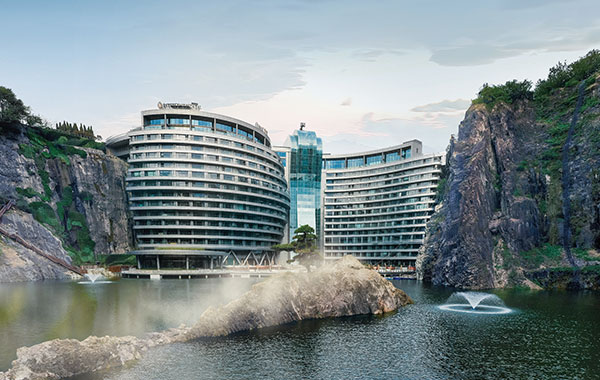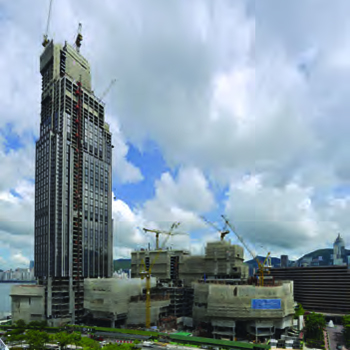Height rank
Victoria Dockside
Hong Kong
- Facts
-
Metrics
You must be a CTBUH Member to view this resource.
Official Name
Victoria Dockside
Other Names
Rosewood Hong Kong
Name of Complex
Type
Building
Status
Completed
Completion
2017
Country
City
Address
Function
A mixed-use tall building contains two or more functions (or uses), where each of the functions occupy a significant proportion of the tower's total space. Support areas such as car parks and mechanical plant space do not constitute mixed-use functions. Functions are denoted on CTBUH "Tallest Building" lists in descending order, e.g., "hotel/office" indicates hotel function above office function.
Serviced Apartments / Hotel / Office
Structural Material
Both the main vertical/lateral structural elements and the floor spanning systems are constructed from steel. Note that a building of steel construction with a floor system of concrete planks or concrete slab on top of steel beams is still considered an “all-steel” structure as the concrete elements are not acting as the primary structure.
All-Concrete
Both the main vertical/lateral structural elements and the floor spanning systems are constructed from concrete which has been cast in place and utilizes steel reinforcement bars and/or steel reinforced concrete which has been precast as individual components and assembled together on-site.
All-Timber
Both the main vertical/lateral structural elements and the floor spanning systems are constructed from timber. An all-timber structure may include the use of localized non-timber connections between timber elements. Note that a building of timber construction with a floor system of concrete planks or concrete slab on top of timber beams is still considered an “all-timber” structure as the concrete elements are not acting as the primary structure.
Mixed-Structure
Utilizes distinct systems (e.g. all-steel, all-concrete, all-timber), one on top of the other. For example, a Steel Over Concrete indicates an all-steel structural system located on top of an all-concrete structural system, with the opposite true of Concrete Over Steel.
Composite
A combination of materials (e.g. steel, concrete, timber) are used together in the main structural elements. Examples include buildings which utilize: steel columns with a floor system of reinforced concrete beams; a steel frame system with a concrete core; concrete-encased steel columns; concrete-filled steel tubes; etc. Where known, the CTBUH database breaks out the materials used within a composite building’s primary structural elements.
All-Concrete
Official Website
Height
272.5 m / 894 ft
Floors Above Ground
66
Floors Below Ground
5
# of Apartments
506
# of Hotel Rooms
413
Tower GFA
127,858 m² / 1,376,252 ft²
Rankings
-
By function
You must be a CTBUH Member to view this resource.
-
By material
You must be a CTBUH Member to view this resource.
Construction Schedule
Proposed
Construction Start
Completed
Owner/Developer
Architect
Usually involved in the front end design, with a "typical" condition being that of a leadership role through either Schematic Design or Design Development, and then a monitoring role through the CD and CA phases.
Structural Engineer
The Design Engineer is usually involved in the front end design, typically taking the leadership role in the Schematic Design and Design Development, and then a monitoring role through the CD and CA phases.
MEP Engineer
The Design Engineer is usually involved in the front end design, typically taking the leadership role in the Schematic Design and Design Development, and then a monitoring role through the CD and CA phases.
Other Consultant
Other Consultant refers to other organizations which provided significant consultation services for a building project (e.g. wind consultants, environmental consultants, fire and life safety consultants, etc).
Other Consultant refers to other organizations which provided significant consultation services for a building project (e.g. wind consultants, environmental consultants, fire and life safety consultants, etc).
These are firms that consult on the design of a building's façade. May often be referred to as "Cladding," "Envelope," "Exterior Wall," or "Curtain Wall" Consultant, however, for consistency CTBUH uses the term "Façade Consultant" exclusively.
Material Supplier
Material Supplier refers to organizations which supplied significant systems/materials for a building project (e.g. elevator suppliers, facade suppliers, etc).
Material Supplier refers to organizations which supplied significant systems/materials for a building project (e.g. elevator suppliers, facade suppliers, etc).
You must be a CTBUH Member to view this resource.
Owner/Developer
Architect
Usually involved in the front end design, with a "typical" condition being that of a leadership role through either Schematic Design or Design Development, and then a monitoring role through the CD and CA phases.
Usually takes on the balance of the architectural effort not executed by the "Design Architect," typically responsible for the construction documents, conforming to local codes, etc. May often be referred to as "Executive," "Associate," or "Local" Architect, however, for consistency CTBUH uses the term "Architect of Record" exclusively.
Ronald Lu & Partners
Structural Engineer
The Design Engineer is usually involved in the front end design, typically taking the leadership role in the Schematic Design and Design Development, and then a monitoring role through the CD and CA phases.
Arup; CM Wong & Associates Limited
MEP Engineer
The Design Engineer is usually involved in the front end design, typically taking the leadership role in the Schematic Design and Design Development, and then a monitoring role through the CD and CA phases.
Contractor
The main contractor is the supervisory contractor of all construction work on a project, management of sub-contractors and vendors, etc. May be referred to as "Construction Manager," however, for consistency CTBUH uses the term "Main Contractor" exclusively.
New World Construction Company Limited
Other Consultant
Other Consultant refers to other organizations which provided significant consultation services for a building project (e.g. wind consultants, environmental consultants, fire and life safety consultants, etc).
Other Consultant refers to other organizations which provided significant consultation services for a building project (e.g. wind consultants, environmental consultants, fire and life safety consultants, etc).
These are firms that consult on the design of a building's façade. May often be referred to as "Cladding," "Envelope," "Exterior Wall," or "Curtain Wall" Consultant, however, for consistency CTBUH uses the term "Façade Consultant" exclusively.
AB Concept Limited; AFSO; BAR Studio; Fiona Barratt Interiors; Joyce Wang Studio; LAAB Limited; Leigh & Orange; nemaworkshop; Parts and Labor Design; Tonychi
James Corner Field Operations; LAAB Limited; PLandscape Co., Ltd.; URBIS Limited
Lighting Planners Associates; Speirs + Major; New World Dynamics
Rosewood Hotel Group
Arcadis; Rider Levett Bucknall
James Corner Field Operations
Material Supplier
Material Supplier refers to organizations which supplied significant systems/materials for a building project (e.g. elevator suppliers, facade suppliers, etc).
Material Supplier refers to organizations which supplied significant systems/materials for a building project (e.g. elevator suppliers, facade suppliers, etc).
CTBUH Awards & Distinctions
Urban Habitat Award, Single Site Scale 2021 Award of Excellence
2021 CTBUH Awards
MEP Engineering Award 2021 Award of Excellence
2021 CTBUH Awards
Research

20 March 2020
Tall + Urban Innovation 2020: Dominant Trends
CTBUH Research
Providing a global overview of tall building development, design and construction, the CTBUH Awards Program and related Tall + Urban Innovation Conference annually survey projects,...
Global News

28 March 2019
Luxury Hotel Anchors Victoria Dockside Redevelopment in Hong Kong
Kohn Pedersen Fox Associates (KPF) has completed the Rosewood Hotel in Hong Kong. The Rosewood Tower anchors the redeveloped Victoria Dockside, Hong Kong’s new creative...
About Victoria Dockside
Victoria Dockside, a US $2.6 billion, 3 million square feet art and design district on the promenade of Hong Kong's iconic Tsim Sha Tsui waterfront. Set to fully open in 2019, the mixed-use development will offer Grade A office space K11 Atelier, an ultra-luxury Rosewood Hotel, Rosewood Residences, and a premier art, design and leisure experiences with unmatched views of Victoria Harbor and Hong Kong Island. The new neighborhood will reinvigorate the Victoria harborfront and create a top destination for both Hong Kong residents and its 60 million annual visitors. Victoria Dockside is built on the site formerly known as Holt's Wharf - a warehouse terminal next to the Kowloon and Canton Railway in Tsim Sha Tsui. Dating back to 1910, Holt's Wharf served as a global freight and logistics hub, connecting the city to the world. The site helped establish Hong Kong's reputation as the gateway to the Far East and played a major role in the city becoming the busiest port in the world.
Conceptualized by acclaimed architectural firm Kohn Pederson Fox, renowned urban designer and landscape architect James Corner and over 100 designers and consultants around the globe, Victoria Dockside is rising as Hong Kong’s striking new landmark on the Tsim Sha Tsui harborfront.
In November 2017, Victoria Dockside reaches major project milestone with opening of its first phase, K11 Atelier, the iconic mixed-use office tower. K11 Atelier is the first workplace that integrates innovation, art and commerce in one building, redefining modern work space by creating an inspiring office environment and interconnected ecosystem for top talent. The exterior of K11 Atelier is exquisitely cladded in Portuguese limestone piers, accented with bronze trims for timeless elegance. K11 Atelier acknowledges the maritime history of the Victoria Dockside site, with the use of natural wood throughout the interiors, building upon the neutral palette of the textured exterior.
The Rosewood Hong Kong opened in March 2019, featuring 322 rooms and 91 suites, as well as 186 Rosewood branded residences accommodating longer stays. With eight bars and restaurants, Victoria Dockside became an active focal point of the new Kowloon waterfront crafted from reclaimed land and looping pedestrian bridge known as Avenue of Stars.
CTBUH Awards & Distinctions
Urban Habitat Award, Single Site Scale 2021 Award of Excellence
2021 CTBUH Awards
MEP Engineering Award 2021 Award of Excellence
2021 CTBUH Awards
Research

20 March 2020
Tall + Urban Innovation 2020: Dominant Trends
CTBUH Research
Providing a global overview of tall building development, design and construction, the CTBUH Awards Program and related Tall + Urban Innovation Conference annually survey projects,...

17 October 2016
New World Centre Remodeling – Sustainable Building Design and Next-Generation Mixed-Use Developments
Jeff Tung, New World Development Company Limited
As one of the most concentrated metropolises in the world, Hong Kong developers and architects face some unique challenges on sustainable building design. The Hong...
Subscribe below to receive periodic updates from CTBUH on the latest Tall Building and Urban news and CTBUH initiatives, including our monthly newsletter. Fields with a red asterisk (*) next to them are required.
View our privacy policy




































